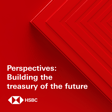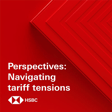Become a Creator today!Start creating today - Share your story with the world!
Start for free
00:00:00
00:00:01

Under the Banyan Tree – New India: What does tech growth mean for jobs?
Fred and Herald talk to Pranjul Bhandari, Chief India Economist, about how tech-focused sectors can more than double the size of the Indian economy in a decade. But can they also provide enough jobs to deal with a rapidly-rising population? Disclaimer: https://www.research.hsbc.com/R/51/wtP77cL Stay connected and access free to view reports and videos from HSBC Global Research follow us on LinkedIn https://www.linkedin.com/feed/hashtag/hsbcresearch/ or click here: https://www.gbm.hsbc.com/insights/global-research.
Hosted on Acast. See acast.com/privacy for more information.
Transcript
Podcast Introduction and Accessibility
00:00:00
Speaker
Welcome to HSBC Global Viewpoint, the podcast series that brings together business leaders and industry experts to explore the latest global insights, trends, and opportunities.
00:00:11
Speaker
Make sure you're subscribed to stay up to date with new episodes.
00:00:14
Speaker
Thanks for listening.
00:00:15
Speaker
And now onto today's show.
00:00:16
Speaker
This is a podcast from HSBC Global Research, available on Apple Podcasts and Spotify.
00:00:22
Speaker
Search for HSBC Global Viewpoint or join us via the HSBC Global Banking and Markets page on LinkedIn.
00:00:29
Speaker
However you're listening, analyst notifications, disclosures and disclaimers must be viewed on the link attached to your media player.
India's Economic Potential and Population Growth
00:00:45
Speaker
Hello and welcome to Under the Banyan Tree, where we put Asian markets and economics in context.
00:00:51
Speaker
I'm Harold van der Linde, head of Asian equity strategy at HSBC in Hong Kong.
00:00:56
Speaker
And I'm Fred Newman, chief Asia economist.
00:00:58
Speaker
On today's podcast, how technology could help more than double the size of India's economy in a decade.
00:01:04
Speaker
Our chief India economist Pranjul Bhandari has just published an in-depth report on this, and she joins us from Mumbai with the details.
00:01:12
Speaker
We'll be casting an eye over the wider Indian economy and of course also look at some of the implications for equity markets.
00:01:19
Speaker
It's one of the more exciting corners in the region.
00:01:21
Speaker
It's time for you to join us under the banyan tree.
00:01:33
Speaker
Well, 2023 is the year when, according to the UN, India will overtake China to become the world's most populous nation.
00:01:40
Speaker
And rapidly growing population means, of course, a lot of jobs are needed.
00:01:44
Speaker
Chief India economist Pranjul Bhandari says tech-focused sectors could push up growth to at least 6.5%.
00:01:51
Speaker
Let's bring in Pranjul right now.
00:01:52
Speaker
Pranjul, welcome to the podcast.
00:01:54
Speaker
Hi, Fred, Harold.
00:01:55
Speaker
Great to be here.
Role of 'New India' in Economic Growth
00:01:57
Speaker
So Pranjal, there's a lot of excitement about New India.
00:02:01
Speaker
It's really a term you coined in one of your latest reports.
00:02:05
Speaker
What exactly do you mean by New India?
00:02:08
Speaker
What sectors do you think of when you coined that term?
00:02:11
Speaker
Yeah, so it's a small part of India, it's about 15% of GDP, but it comprises of everything high tech, in particular exports of goods and services.
00:02:21
Speaker
You know, India has been gaining global market share in things like the exports of mobile handsets, drugs and pharmaceutical products, specialized chemicals, automobiles.
00:02:31
Speaker
But it also has the exports of services where India has really gone up the value chain.
00:02:36
Speaker
It's not just a provider of IT services, but it's increasingly doing a lot of R&D and design work as well.
00:02:43
Speaker
The second part is the tech startups ecosystem.
00:02:46
Speaker
On the back of India's digital public infrastructure, many startups have come out with new business ideas, providing digital solutions to many real economy problems, attracting a lot of inflows and creating growth.
00:03:01
Speaker
So you talk a lot about very exciting new economy sectors here.
00:03:06
Speaker
It's only 15% of GDP, but what does it mean for overall GDP growth?
00:03:10
Speaker
Does that help to accelerate GDP growth?
00:03:13
Speaker
Right.
00:03:14
Speaker
You know, if New India continues to rise in the way it's been doing in the last few years, our sense is that overall GDP growth over the next decade could be about 6.5% per year, which is more than the 6% growth we saw in the pre-pandemic period.
00:03:29
Speaker
So much, you know, higher potential growth for India.
00:03:32
Speaker
And over the next decade, this would mean that India's economic size will actually more than double.
Challenges in Employment and Economic Sectors
00:03:38
Speaker
Hey, Pranjul Harold here.
00:03:40
Speaker
We know this year India is becoming the most populous nation on the planet, overtaking China.
00:03:47
Speaker
It is a young population, so there's a lot of people that enter the labor markets.
00:03:51
Speaker
That 6.5% GDP growth rate and the rise of New India, will that be enough to take on all these new people that are looking for a job out there?
00:04:00
Speaker
Great question, Harold.
00:04:01
Speaker
And the short answer is no.
00:04:02
Speaker
You know, new India makes up 15% of GDP, but it only hires 5% of India's labor force.
00:04:09
Speaker
And India has to create about 70 million new jobs in the next decade.
00:04:13
Speaker
And our sense is that with 6.5% growth, it'll only create about one third of the jobs.
00:04:20
Speaker
I think what India needs really is more than 6.5% growth if it really wants to get enough jobs on the table.
00:04:27
Speaker
And how will India get there?
00:04:28
Speaker
So the service sector is not so labor intensive.
00:04:32
Speaker
You say there's not so many jobs being created in that sense, but it's good for growth.
00:04:36
Speaker
So what kind of growth levels does India need to get there to absorb that labor?
00:04:41
Speaker
Right.
00:04:42
Speaker
If you want to move from 6.5% to 7.5% growth, we can't just rely on new India.
00:04:47
Speaker
We also have to pull up old India, which is basically India's sluggish agriculture and India's low and medium tech manufacturing, which is not very dynamic and not very exciting.
00:04:58
Speaker
What we really need and I think what we have right now is the private sector participating.
00:05:04
Speaker
A lot of the startups have been focusing on services but my sense is that if at some point they move into manufacturing, say digitization of manufacturing,
00:05:13
Speaker
or agri-tech, they could energize these sectors and that's where we could get our 7.5% growth from.
00:05:20
Speaker
By the way, if India does grow 7.5% over the next decade, it will probably be able to create about two-thirds of the 70 million jobs that I was talking about.
00:05:29
Speaker
That's pretty impressive, raising growth potentially 7.5%.
00:05:34
Speaker
It is a very high number, yeah.
00:05:35
Speaker
Maybe this is a good time to take a little break here.
00:05:37
Speaker
And when we come back, we're really going to talk about the bigger picture, how India compares to other development stories out there in emerging markets.
00:05:54
Speaker
Welcome back.
Reforms Needed for Enhanced Growth
00:05:55
Speaker
We've spoken so far about the rise of new India, the difficulties of maybe absorbing all kinds of new people that come to the labor market in India and the growth rate that we need to see in order to get there.
00:06:07
Speaker
But I have a question, Pranjul, for you.
00:06:10
Speaker
What sort of policies do we need to see to get to growth rates of something like 7.5% in India?
00:06:16
Speaker
What does the government need to do to achieve that?
00:06:20
Speaker
Yeah, thanks.
00:06:21
Speaker
So I think a lot of things are number one, it needs to keep doing reforms.
00:06:26
Speaker
We've had some good reforms in the past, but that's not good enough.
00:06:29
Speaker
We need new reforms on the tax front, on lowering tariffs, on the power sector, and also a new framework for climate change.
00:06:36
Speaker
So all of that must happen.
00:06:38
Speaker
Private CapEx has been weak for the last decade.
00:06:41
Speaker
It's showing some good signs, but it really needs to rise up to sort of get to higher growth.
00:06:47
Speaker
Educational standards and employability of people has to improve.
00:06:50
Speaker
There was a setback in the pandemic period, but corrective measures must be taken.
00:06:54
Speaker
And finally, world growth must be strong enough to be able to absorb a country like India growing fast.
00:07:01
Speaker
So, Pranjra, let's take a let's zoom out a little bit and put India into context.
India's Unique Growth Path and Globalization Benefits
00:07:05
Speaker
What you're talking about here is a potential acceleration of growth if we, of course, pursue the right policies.
00:07:12
Speaker
But it also is in a unique moment with new technology driving new India.
00:07:17
Speaker
How would you then describe how India might compare to other emerging markets?
00:07:21
Speaker
We have in Asia, for example, many emerging markets have gone through a takeoff phase in economic development earlier, arguably, than India.
00:07:30
Speaker
Is India following the same development path now, or how do you think of it in a comparative context?
00:07:37
Speaker
Yeah, so if India was to grow 6.5% to 7.5% in the next decade, the economic size would more than double in a decade.
00:07:44
Speaker
It would become the third largest economy in the world by 2027.
00:07:47
Speaker
It would obtain the upper middle income status in a couple of years.
00:07:52
Speaker
But I think the most important way to be different from some of the other emerging markets is its share of services in GDP.
00:07:59
Speaker
That's likely to be high, around 55 to 60% of GDP, one of the highest in the EM space.
00:08:06
Speaker
And in a way, you can say that India is going to benefit from the fact that globalization of services continues, even if trade in goods has slowed a little bit.
00:08:18
Speaker
So, Harold, that's also a question for you, really, when it comes to equity markets, right?
00:08:23
Speaker
You look at emerging market equity markets on a comparative basis.
00:08:28
Speaker
Pranjal mentioned service sector being slightly larger compared to maybe other economies at the same level of development.
00:08:34
Speaker
What does this mean for equity markets?
00:08:37
Speaker
Well, I would say there's two key differences where India really stands out.
00:08:40
Speaker
So, yes, part of that service sector is listed in the stock market.
00:08:44
Speaker
So we've got the IT companies that are listed amongst others, the pharma companies that provide a service to the rest of the world.
00:08:50
Speaker
So that is, it broadens and makes it a very diverse stock market.
00:08:53
Speaker
But what I think is probably even more important is that...
00:08:56
Speaker
The nature of the demographics, the structure of the whole economy is so different that, for example, where consumers are located, what they buy and how they buy is completely different than it is in, for example, China.
00:09:12
Speaker
In China, you get most people close to the factories because that's where they work on the eastern seaboard of China.
00:09:20
Speaker
And that's where most of the money is located.
00:09:22
Speaker
So if you come in
00:09:23
Speaker
with a luxury product, you go to the top 10 cities in China, you capture that.
00:09:28
Speaker
In India, it's completely different.
00:09:30
Speaker
Luxury doesn't go as well there, but you need to go into not 10, but hundreds, if not thousands of mid-sized towns that are more scattered across the region and the consumption patterns are different.
00:09:40
Speaker
So in India, distribution capability is much more important than in China.
00:09:45
Speaker
China branding is more important because that is really a big barrier to entry.
00:09:50
Speaker
Indian companies have emerged as the most profitable companies
00:09:53
Speaker
In Asia, in the emerging markets, I would say, they belong to the most profitable companies on the planet.
Future Opportunities Across Asia
00:09:58
Speaker
So a different development path really that we're spelling out here with implications for investors, different opportunities.
00:10:05
Speaker
And Pranjul, sounds like the new economy is igniting in India and with the right policies, we're really going to see a decade of tremendous growth ahead.
00:10:16
Speaker
So thank you for sharing your insights, Pranjul.
00:10:18
Speaker
This is certainly a developing story.
00:10:20
Speaker
It's one of the most exciting stories, I think, that we have across the region.
00:10:23
Speaker
There's a lot of visible growth in the next couple of years.
00:10:27
Speaker
It's an exciting place to be in Asia.
00:10:28
Speaker
So, Pranjal, we certainly have you back.
00:10:30
Speaker
Thanks for joining us.
00:10:31
Speaker
Great to be here.
00:10:32
Speaker
Thank you for having me.
Casual Conversations and Personal Insights
00:10:42
Speaker
So, Fred, let's step away from work for a moment.
00:10:45
Speaker
What are your plans for the weekend?
00:10:47
Speaker
Well, Harold, as you know, my family situation has changed.
00:10:50
Speaker
I have a four-month-old boy at home, and obviously we struggle every weekend with how we entertain him.
00:10:55
Speaker
But we discovered, actually, that he likes art, art museums in particular.
00:10:59
Speaker
And so we like art, and so we're just at that sweet spot where he still finds it interesting.
00:11:05
Speaker
So we go to museums, he looks at these wonderful colors.
00:11:09
Speaker
I have a feeling, though, it might not last very long, so I probably will find myself on some playground or some zoo in the near future
00:11:15
Speaker
Yeah, dolphins and these things.
00:11:16
Speaker
While we can go to museums, I think I'll enjoy that.
00:11:19
Speaker
But any museums coming up in your future, Harold?
00:11:22
Speaker
Yeah, not this particular weekend, but I'm going to fly back to Holland and see some family.
00:11:26
Speaker
But I want to go to a rather small museum in the city of Leiden where there's a particular statue.
00:11:31
Speaker
As you know, Fred, I'm looking at Indonesia's history.
00:11:33
Speaker
It's a bit of a hobby of mine.
00:11:35
Speaker
And one of the first kings that you could argue has united Indonesia as it is in the late 1200s, 1280, 1290 we're talking about here is
00:11:43
Speaker
was a king called Kertanegara and there's a statue of him quite odd whereby he's naked dancing on a graveyard with skulls around his neck and it was really to build up kind of power, spiritual power to get the country together and defend it against what he considered enemies that were attacking the region.
00:12:01
Speaker
So it might not be really appropriate for small children though but it's really an interesting statue to take a look at.
00:12:07
Speaker
And then you're trying to sort of reenact that, or is that not part of the trip?
00:12:12
Speaker
I might try to do that, but I'm not going to send you any pictures of that.
00:12:15
Speaker
All right, Harold.
00:12:16
Speaker
Well, enjoy your holidays.
00:12:17
Speaker
You enjoy your museums as long as it lasts.
00:12:20
Speaker
Yes.
00:12:21
Speaker
And thank you, ladies and gentlemen, for joining us.
00:12:23
Speaker
And see you again here under the banyan tree next week, same time.
00:12:26
Speaker
Cheers.
00:12:36
Speaker
Thank you for joining us at HSBC Global Viewpoint.
00:12:39
Speaker
We hope you enjoyed the discussion.
00:12:41
Speaker
Make sure you're subscribed to stay up to date with new episodes.

















